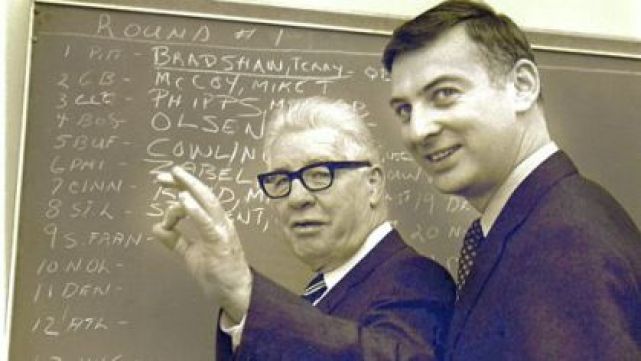Sorry to give you all a collective anxiety attack, Steelers fans, but you deserve to know exactly how fortunate it is that Pittsburgh both drafted and kept Hall of Fame quarterback Terry Bradshaw.
Not only did the Steelers have a mere 50-50 chance at the No. 1 pick in the 1970 NFL draft, but once the team secured that selection, it did everything in its power to trade that prime draft real estate for a collection of assets.
Sometimes, it takes a combination of luck and fortuitous inaction to strike gold. There are few better examples of that scenario playing out perfectly across sports than the events that led up to the Steelers drafting Bradshaw 50 years ago Monday on Jan. 27, 1970, a decision that helped lead Pittsburgh to four Super Bowls in the late ’70s and early ’80s.
First and foremost, the Steelers only received the No. 1 overall pick in the draft because they won a coin flip. That’s right, the team’s ticket to reversing the cycle of mediocrity it had been stuck in since 1933 came down to then-Steelers vice president Dan Rooney feeling lucky.
See, the Steelers and Chicago Bears both finished 1-13 — the worst records in the NFL — during the previous season. So the league set up a coin toss in New Orleans during Super Bowl week to decide who got the first pick, because apparently the sorts of tiebreakers used to settle these situations today hadn’t been invented yet.
Rooney won, and the pick was the Steelers’. Now, they just had to keep it.
This was the headline the Pittsburgh Press ran with Pat Livingston’s story on Jan. 27, 1970, about the Steelers drafting Bradshaw.

Yes, the Steelers seemingly did everything in their power to shop that pick — which everyone presumed would be Bradshaw — to any bidder willing to give up enough assets for the organization to ostensibly start rebuilding.
Here’s the lede to Livingston’s story: “The Steelers, hoping until the last minute that somebody might call and offer them Superman for their first-round draft pick, went ahead and selected quarterback Terry Bradshaw at the start of pro football’s college grab bag today.”
Owner Art Rooney was quite open about his willingness to trade the pick if the right offer came along.
“The closest I ever came to making a demand was this year,” he told Press sports editor Roy McHugh on Jan. 28. “I said if we’re going to trade Bradshaw, we’re not going to trade him for ordinary, run-of-the-mill guys. I don’t care about quantity. If we’re giving away a guy who’s going to be a great ball player, let’s make sure we get proven ball players in return.
“And if the other club won’t give you what you want, forget it.”
The Steelers came close to finding their desired deal with the St. Louis Cardinals, according to McHugh. They would’ve traded the pick for the Cardinals’ selection and four starters, with the only condition being that Penn State defensive tackle Mike Reid still had to be on the board when St. Louis picked at No. 8.
The Cincinnati Bengals wound up taking Reid at No. 7 overall, so the deal fell through. In a roundabout way, one of the Steelers’ oldest and most-hated rivals played a part in cementing a decade-long dynasty for Pittsburgh.
Dan Rooney told Livingston in the same Press story that the Steelers “didn’t come close to making a trade” for that pick and Bradshaw was their guy since he won that coin flip in New Orleans.
“The basis of our decision to draft Bradshaw is to strive to produce a championship as soon as possible,” he said. “We are not just interested in respectability in between.”

After all the politicking was over, the Steelers selected Bradshaw first overall. Coach Chuck Noll was thrilled that his team took the guy he believed was the best quarterback in his draft class.
“Terry is an extremely accurate drop-back passer and he can take off and run with the ball if necessary,” Noll told the Post-Gazette’s Jack Sell on Jan. 28. “… Terry convinced me he was the most valuable piece of property in the college ranks.”
This pick did not bode well for incumbent Steelers quarterbacks Dick Shiner, Kent Nix and Terry Hanratty. But Hanratty didn’t seem too worried about his job security.
“I don’t think it makes that much difference,” he told Livingston on Jan. 27 from Fort Bragg, N.C., where he was stationed until May 10, 1970, as he served Army duty. “I’ve had a lot of competition, both in college and with the Steelers, and I’m confident that I’ll be good enough.”
Unfortunately for Hanratty, confidence can only get you so far in professional sports.
Bradshaw, for his part, seemed excited to join the Steelers, though he was still fearful of being traded based on a phone call from Chicago he received at his Shreveport, La., home the night before the draft.
Nothing ever came of that interaction, but he was still on guard.
“When they called I was so happy I didn’t know what to do,” Bradshaw told the Press’ Phil Musick on Jan. 27, referring to Pittsburgh informing him that he was now a Steeler. “I sure hope they don’t get rid of me. That’s all I’ve heard all morning … that they’re going to trade me.”
Luckily for the organization and its fans, the Steelers kept Bradshaw and helped him develop into a Hall of Famer. It’s also worth mentioning that Pittsburgh took a cornerback out of Southern University in the third round of this draft named Mel Blount. The Steelers selected the only two Hall of Famers in the 1970 draft.
In the end, it took solid scouting from Noll and the Rooneys, a lucky coin flip and some help from the Bengals to ensure Bradshaw was taken and retained by the Steelers.
It was touch-and-go for a minute there, but all’s well that ends well.